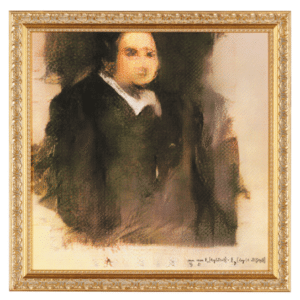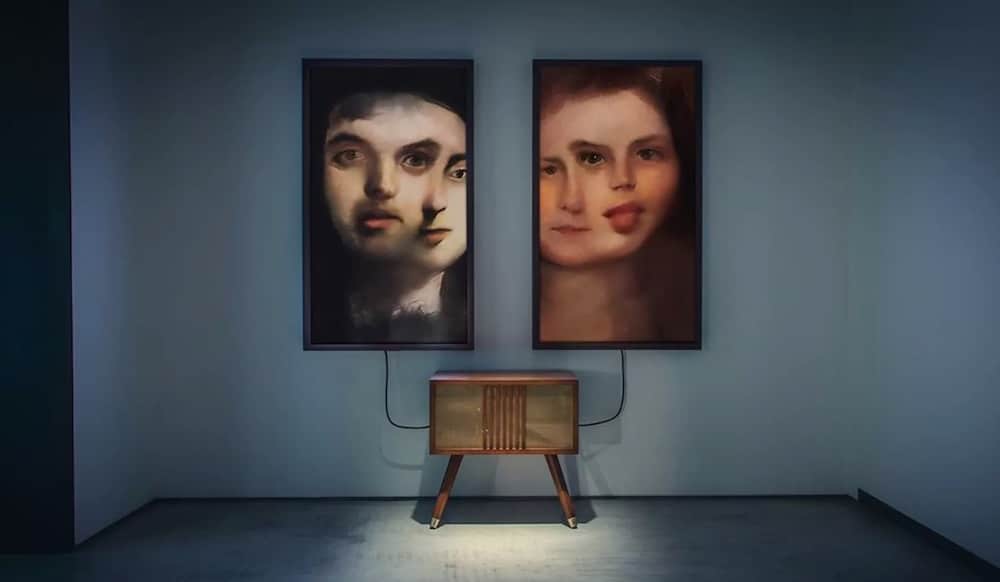Art has always been a reflection of the human experience, showcasing creativity, emotions, and unique perspectives. However, as technology continues to advance, the emergence of AI has sparked discussions about its impact on the art business and its potential to replace artists. In this article, we will delve into the pros and cons of AI art and it’s implications for the art collector and artist community.
Understanding AI in the Artistic Realm
Artificial intelligence refers to the ability of computer systems to perform tasks that would typically require human intelligence. In the context of art, AI algorithms are trained to analyze and replicate artistic styles. This creates artworks that are indistinguishable from those created by human artists. This technology has rapidly advanced, generating compelling pieces that have made their mark in the art world.
One example of AI-generated art that gained significant attention is “Portrait of Edmond de Belamy.” Created by the art collective Obvious, this AI-generated artwork was sold at auction for $432,500. It demonstrated that AI has the capability to produce artworks that are not only aesthetically pleasing but also commercially viable

The Rise of AI in Art Creation
One of the significant advantages of AI-generated art lies in its precision, speed, and consistency. AI algorithms can analyze vast amounts of data, learning from existing artworks to replicate various styles and techniques flawlessly. This level of accuracy and efficiency has the potential to revolutionize the art creation process, offering a new level of accessibility to aspiring artists.
For example, the DeepArt algorithm developed by Leon Gatys allowed users to transform their photographs into paintings in the style of famous artists such as Van Gogh or Picasso. This AI-powered tool democratized art creation by enabling anyone, regardless of artistic skill, to produce visually stunning pieces in the style of renowned artists.
However, some critics argue that AI-generated art lacks the intangible qualities that make human-made art special. Professor Ahmed Elgammal, director of the Art and Artificial Intelligence Lab at Rutgers University, states, “Art is not about replicating style or visual elements; it’s about the expression of the artist’s creativity, imagination, and emotions. AI cannot genuinely understand these aspects of human experience.”
AI and Artistic Collaboration
Rather than replacing artists, AI can serve as a powerful tool for collaboration. Artists can harness the capabilities of AI algorithms to augment their creative process and explore new possibilities. AI can be used to generate ideas, experiment with different styles, or even assist in the production process. By embracing AI as a tool, artists can expand their artistic boundaries and develop new avenues of expression.
An example of successful collaboration between AI and human artists is the work of Mario Klingemann, a prominent artist who utilizes AI algorithms in his artistic practice. Klingemann uses AI to generate source material and ideas, which he then combines with his artistic sensibilities to create unique and thought-provoking artworks. This collaboration allows him to push the boundaries of his creativity and create pieces that would not have been possible without AI.

Art Collectors and the Impact of AI
The rise of AI-generated art has significant implications for art collectors. On one hand, it offers a new range of artworks to explore and collect. AI-generated pieces can be precise, consistent, and produced at a faster rate than human-made art, making them more accessible to a broader audience. Additionally, AI art challenges the traditional notions of authorship and originality, raising intriguing questions about the value and authenticity of art in the digital age.
Pierre Fautrel, co-founder of the art collective Obvious, explains, “AI-generated art has the potential to disrupt the art market by blurring the lines between traditional and digital art. It challenges the notion of originality and forces us to rethink the value we place on human creativity versus machine creativity.”
However, some art collectors may argue that AI-generated art lacks the emotional connection and narrative depth that human-made art provides. The human touch, imperfections, and the artist’s unique perspective contribute to the allure and value of traditional artworks. As collectors navigate this new landscape, they must consider the pros and cons of AI-generated art and its impact on their collections.
The Future of Artists in an AI-driven Art World
Despite the advancements in AI-generated art, the role of human artists remains essential. While AI can mimic styles and replicate techniques, it lacks the ability to think and feel as humans do. Artists possess the capacity to infuse their work with personal experiences, emotions, and thought-provoking concepts. Human artists bring a distinct voice and vision to their creations, offering a depth of expression that AI cannot replicate.
Renowned artist and AI pioneer, Refik Anadol, believes that AI can be a powerful tool for artists, stating, “AI is not about replacing artists; it’s about amplifying human creativity. It opens up new possibilities and allows artists to explore uncharted territories, pushing the boundaries of what is possible in art.”
In this new era, collaboration between human artists and AI algorithms can be a powerful avenue for artistic exploration. Artists can use AI as a tool to expand their creativity, enhance their techniques, and explore new artistic territories. The combination of human intuition and AI’s computational power opens doors to innovative and thought-provoking artworks that blur the boundaries of traditional artistic practices.
Pros and Cons of AI Art
Pros
- Precision and Consistency: AI algorithms can analyze vast amounts of data and replicate artistic styles with remarkable precision. This level of accuracy ensures consistent quality in AI-generated artworks.
- Speed and Accessibility: AI-powered art creation can be significantly faster than traditional human-made art. This increased speed allows for a larger volume of artworks to be produced, making art more accessible to a wider audience.
- Exploration of Styles and Techniques: AI algorithms can analyze and replicate various artistic styles, enabling artists to experiment with different techniques and expand their creative boundaries.
- Democratization of Art: AI-generated art has the potential to democratize art creation by making it more accessible to individuals without extensive artistic training. It allows aspiring artists to produce visually stunning pieces and express their creativity without traditional artistic skills.
Cons
- Lack of Emotional Depth: One of the main criticisms of AI-generated art is its perceived lack of emotional depth and narrative complexity compared to human-made art. AI algorithms can replicate styles but often struggle to capture the intricacies of human expression, personal experiences, and subjective interpretations.
- Originality and Authenticity: The question of originality arises in AI art, as the algorithms learn from existing artworks and generate new pieces based on that knowledge. Some argue that AI-generated art lacks true originality, as it relies heavily on existing artistic styles and does not possess the same level of conceptual innovation that human artists bring to their work.
- Ethical Considerations: AI-generated art raises ethical dilemmas concerning authorship, intellectual property rights, and the proper recognition of creators. Determining who should be credited as the creator of AI-generated artworks can be challenging, as AI algorithms are designed by humans but generate output independently.
- Biases and Lack of Diversity: AI algorithms learn from datasets, which may contain inherent biases. This can perpetuate inequalities and limit artistic diversity in AI-generated art. It is crucial to ensure that AI art creation remains inclusive and does not reinforce existing biases or cultural stereotypes.
Ethical and Philosophical Implications
he rise of AI-generated art raises ethical dilemmas and philosophical questions. Who should be credited as the creator of AI-generated artworks? Should AI-generated art be considered original and authentic?
The question of authorship becomes particularly challenging in AI art, as the algorithms themselves are designed by humans, yet the output is generated by the AI system. This raises debates about intellectual property rights, as well as the recognition and attribution of AI-generated artworks.
Moreover, AI algorithms are trained on existing datasets, which may contain inherent biases. This poses a risk of perpetuating inequalities and limiting artistic diversity in AI-generated art. It is crucial to ensure that AI art creation remains inclusive, celebrating a wide range of artistic styles and perspectives.
Conclusion
AI-generated art presents both advantages and challenges for the art world. While it offers precision, speed, and accessibility, it may lack the emotional depth and originality associated with human-made art. The ethical considerations surrounding AI art, such as authorship and biases, require careful reflection and discourse.
Ultimately, the future of art lies in finding a balance between AI and human creativity, leveraging the capabilities of AI as a tool to enhance artistic expression. By embracing the pros and addressing the cons of AI art, we can navigate this evolving landscape and foster a collaborative and inclusive artistic environment.

